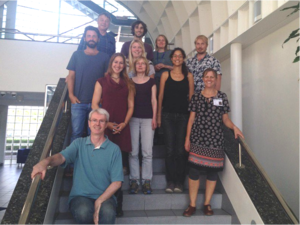Leading scientists from across the world travelled to NOC for the first TOMCAT working group meeting.
This group aims to take advantage of the fast development of optical technologies to help progress understanding of the ocean carbon cycle, which determines CO2 levels in the ocean and atmosphere, using large data sets describing particles in the ocean.
TOMCAT (Translation of Optical Measurements into particle Content, Aggregation & Transfer) is a Scientific Committee of Ocean Research (SCOR) working group.
Sinking particles transport organic matter to the deep sea, where they form the base of life. The amount of particles transported to the deep ocean, and the rate at which particles are consumed by marine life, determines carbon sequestration in the oceans, as well as directly influencing atmospheric CO2 concentrations and global climate. Traditionally, sinking particles have been collected using sediment traps. However, these have limited spatial and temporal coverage. New technologies that focus on optical measurements allow the collection of large data sets describing both frequencies and types of sinking particles. These can be used from ships, or installed on remote platforms, promising greater spatial and temporal coverage.
Dr Emma Cavan from the NOC and The University of Southampton, who is a member of TOMCAT, said “It’s really important to standardize methods internationally, from sampling to processing, and this group has the unique opportunity to highlight current issues and successes in using optics to infer particle flux in the ocean.”
TOMCAT aims to advance and promote techniques to analyse the often immense data sets.
Dr Klas Moeller from the Helmholtz-Zentrum Geesthacht, Germany, said “it was great meeting and discussing with leading experts from across the field during the last days and I think we were really successful.”
Dr Catarina R Marcolin, University of Southern Bahia, Brazil added "The TOMCAT meeting was just amazing. It was a great opportunity to get deep into the work of excellent researchers from distinct parts of the world. All of us provided honest presentations about the pros and cons of our own works with optical devices, which shall turn into an important review for this field of research. I’m proud to be part of this group.”
TOMCAT will now work on a review and recommendations on how to best translate optical measurements into particle processes and fluxes. For more information see https://tomcatscor.wordpress.com.

